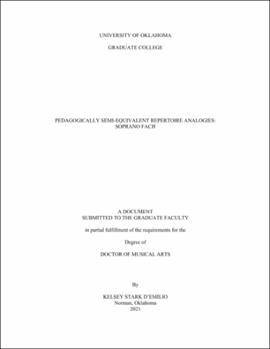| dc.description.abstract | For decades, conservatories have divided singing into two tracks: classical (voce chiusa) or musical theater (CCM). Young singers are forced to decide which track they will continue on—seemingly for the rest of their careers. But the demand for a single skill set does not reflect today’s job market nor the vocal demands singers will face throughout their careers. Singers, instead, must be readily able to compete at high levels on more than one track. Yet the majority of programs have not restructured to accommodate this change. Such recalcitrance is detrimental to singers as they navigate high-stakes, high-pressure careers with little to no knowledge of crucial skills they may need. Often this can lead to over-singing, poor vocal health, and sometimes the end of a career.
I propose a way in which both tracks—voce chiusa and CCM—can be used symbiotically. This combinatorial approach is good for future careers, but more importantly, it is beneficial to a singer’s intrinsic laryngeal muscle development. Finding a healthy belt for voce chiusa-trained singers is equally beneficial as finding a strong head-voice for CCM singers. This synthesis of vocal techniques actually yields a super-technique—a more flexible, healthy, and individualized sound that is unified through the use of the breath.
This document is an exposition of the pedagogical benefits of learning both traditional, voce chiusa and CCM repertoire concurrently in vocal training. I also offer repertoire that supports this combinatorial approach in order to make its utility in the voice studio more accessible. This repertoire features pedagogically semi-equivalent song pairings with a focus on the soprano Fach. I will highlight the major areas of equivalence and pedagogical efficacy shared by the voce chiusa and CCM repertoire paired. Twenty-five style pairings are offered as a sample of the future catalog I hope to aggregate for all major voice types. The purpose of the catalog is to incorporate pluralistic style in the studio by combining the pedagogical methods of voce chiusa and CCM singing in order to train singers to have greater vocal development, flexibility, and health. | en_US |
